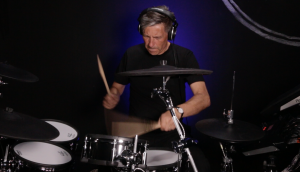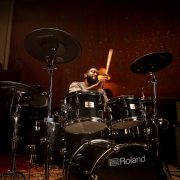Recording acoustic drums is one of the biggest challenges there is in recording. Recording your own drums as you play, raises the level of difficulty even further!
This simple guide looks at the three most common ways of recording the drum kit.
- Acoustic drums (with microphones)
- Audio and MIDI Performance Direct via USB (electronic kit)
- Hybrid acoustic/electronic kit (microphones and triggers)
Recording Acoustic Drums
This part might be simple but if you start counting how many mics you need – kick, snare, toms, HH, overhead and the room, it starts to add up.
Most professionals close mic and room mic drums to capture the overall sound and give them options when mixing. It’s not uncommon to use twelve mics or more on just the drums.
A multi-channel audio interface or mixing desk to handle all these is required and don’t forget that you need stands and cables for each channel too!
Lastly, everything, including the kit and equipment needs to be placed precisely to account for phase cancelling and room acoustics then once the drums are recorded, noise gates, compression and precise balancing and equalization of all the recordings needs to be done just to make it sound like a nice kit.
As you can see, creating the ideal acoustic drum recording is an expensive and endless endevour but a fun challenge.
What Gear Do You Need For Recording Acoustic Drums?
- Audio Interface with multiple microphone inputs
- Microphones
- Microphone stands
- Balanced microphone cables
- Monitor headphones or speaker system
-
Computer
- DAW Recording Software
- A recording space
Audio Interface
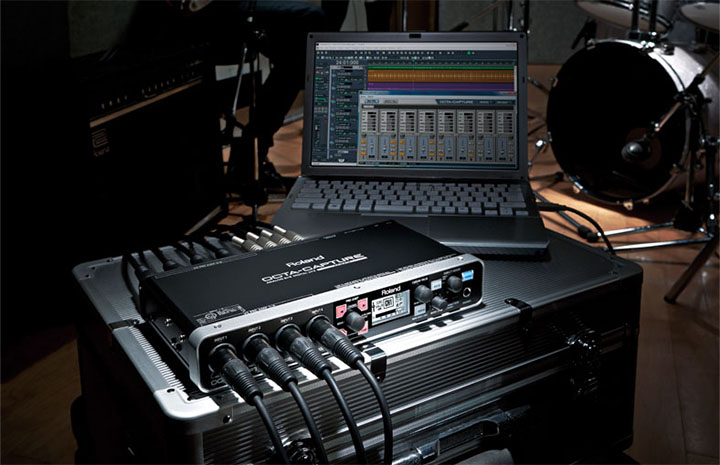
This is what takes the signals from the microphones, amplifies them and passes them through to the recording software to capture your performance. For recording acoustic drums, a minimum of eight microphone channels is a good start.
Interfaces usually offer a combination of other analog and digital inputs along with line level and headphones outputs for listening to the recordings. The most common way they connect to the computer is via USB.
The interface pictured above is the Roland OCTA-CAPTURE.
Microphones, stands and cables
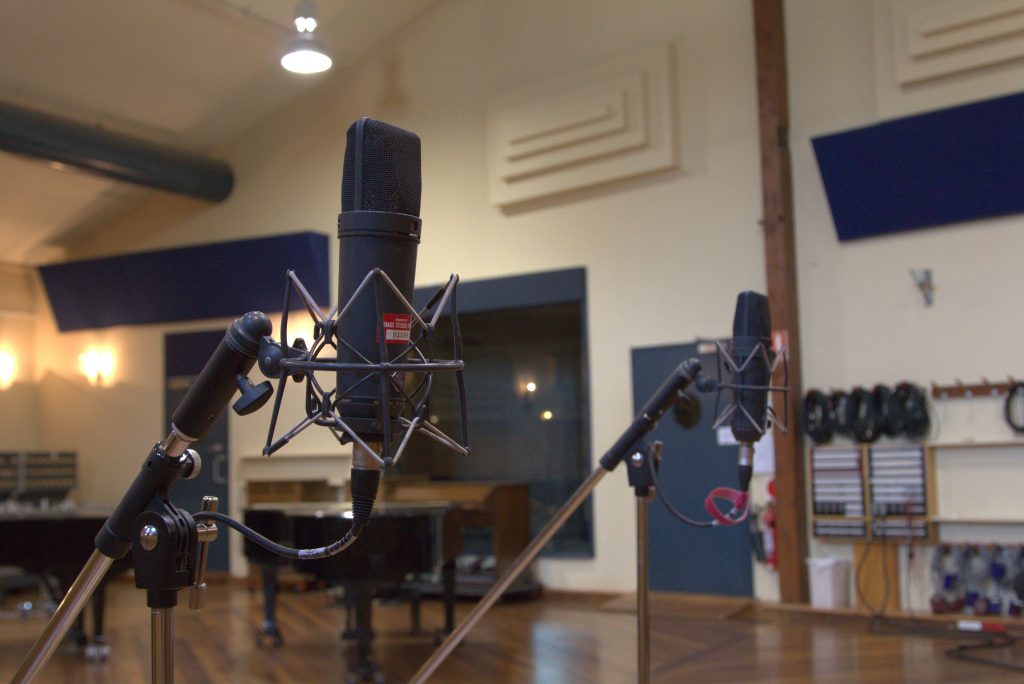
Unfortunately, there’s no one size fits all drum microphone. A combination of small and large diaphragm condenser microphones along with dynamic and ribbon mics are often used to capture the overall sound of the kit.
In practice, many engineers change the polar or pickup pattern or swap out the capsule head completely on individual microphones to capture the sound from a different perspective or reduce the ‘bleed’ from nearby drums.
Multi-pattern microphones are more expensive than standard fixed pattern microphones because they often have several internal membrain capsules and more complex circuitry.
Heavy stands that can handle the weight of a bulky microphone over the top of the kit are required and sand bags are often used too.
For cables, think carefully about how far the kit will be from the recording interface and double the length you think you need. Cables will need to run along the floor out of the way and up the stand to the mic which might be several meters up in the air.
Room
The most famous drum recordings have something special about the sound and often, it’s the room the plays a significant part.
Famous drum recording rooms like those at Avatar, Real World, Abbey Road were designed specifically to highlight the most desireable aspects of acoustic instruments and minimise the negatives.
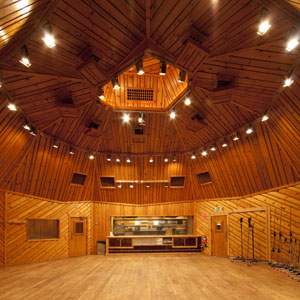
Most world class studios have at least one area or dedicated room for drums be it live and reflective through the use of glass, concrete and tiles or darker and more rounded with the use of wood. Often, rooms have movaeable panels, sliding doors, partitions and curtains for changing the reflectiveness and character of the room quickly.
The room shape, size and materials are carefully planned well before a single nail is struck and significant testing and modifications often continue throughout a studio’s life to change with the current trend in recording techniques and drum sounds.
When recording at home, chose the largest room first as you always need lots of space around drums. If you are recording yourself, plan how you’ll get access to the kit and your computer.
Don’t lock yourself in and make the whole experience uncomfortable and even more difficult.
Recording Electronic Drums
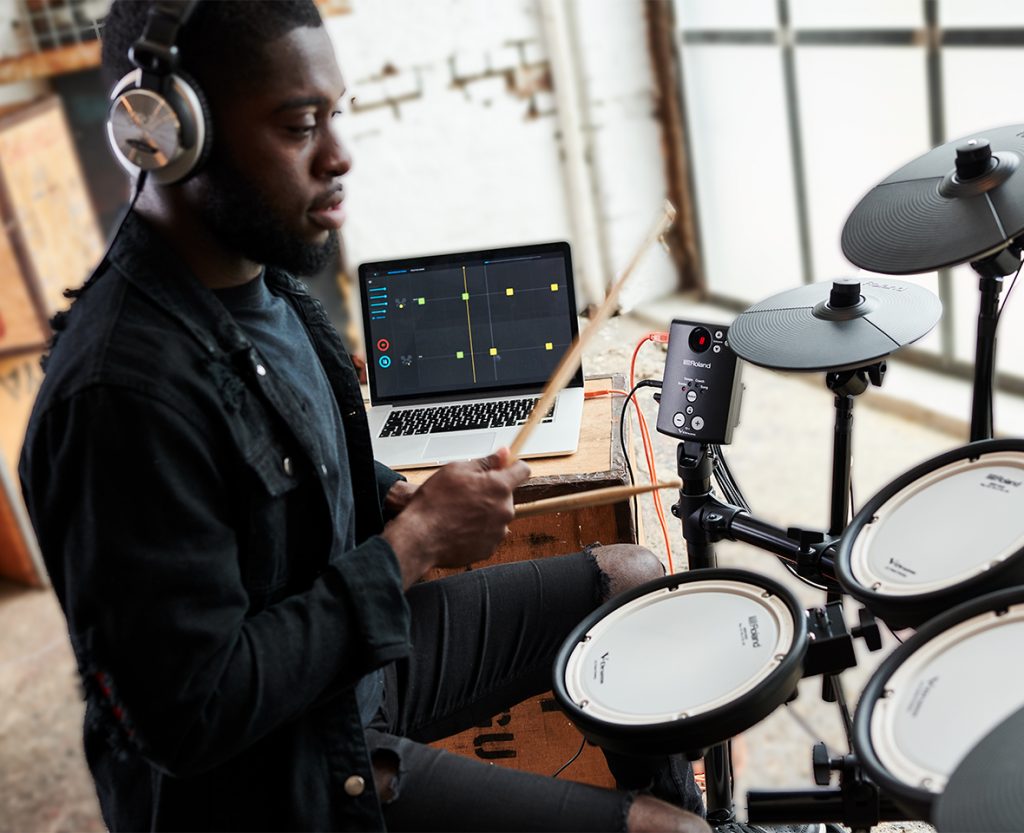
With electronic drums, the expensive and hard work has already done for you!
Recording V-Drums is as simple as connecting a single cable so from an ease of use perspective, there’s just no competition.
Being able to put the technical recording aspects to one side and just play, makes all the difference when it comes to saving your energy so you can enjoy playing and in the end, get the best recorded performance.
Here are the main benefits of recording electronic drums:
- You don’t need an acoustically designed room to record electronic drums
- No microphones or microphone preamplifiers are required
- The recording sessions are much quieter
- No additional noise is introduced into the drum recordings
- It’s possible to record wherever your kit is; Set it up how and where you like
- Notes can be erased, added and moved anytime easily
- Performances can be quantised for tight timing
- Drum notation is possible from the drum performance
- Recordings can be made into the module itself or any computer or laptop and even into your phone wirelessly via Bluetooth
- Drum sound choices can be made anytime after recording, during editing and even at the mix stage
With audio and MIDI interfaces built-into the sound module these days, both the note performance and audio sound can be transmitted digitally to and from a compatible computer system without the need of any other recording interface.
How MIDI data is used
The MIDI data is essentially:
1) which note/drum,
2) how hard it was struck
3)when it was played are recorded into the recording software.
From there, the individual notes can be moved, copied, added or deleted, quantized and arranged as required for the perfect performance.
The notes are then sent back to the module or to a drum plug-in software to generate the sounds you hear.
The sounds played back are limitless and don’t have to be just drums. For example, you can copy the drum notes to a different instrument track and have them playing piano, bass or any other sound for the ultimate creative possibilities.
See the articles below for how to record each Roland V-Drums kit.
TD-27 V-Drums Kit Recording Guide
TD-17 & TD-25 V-Drums Recording Guide
TD-1 V-Drums Kit Recording Guide
TD-50 V-Drums kit Recording Guide
TD-07KV V-Drums kit Recording Guide
TD-02 V-Drums kit series Recording Guide
Equipment Needed to Record V-Drums
- Monitor Headphones or Speaker System
Hybrid Acoustic and Electronic Drum Recording
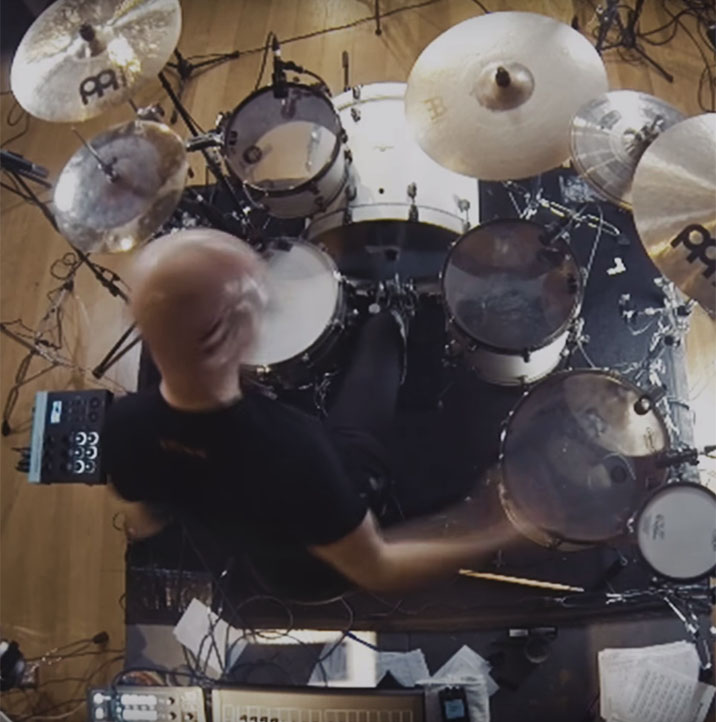
One of the ways to enhance or dramatically change an acoustic drum sound is to layer it with other sounds with the use of acoustic piezo triggers and hardware and software.
This is commonly referred to as ‘Hybrid Drumming’.
Read more about the possibilities of hybrid drumming here.
Drum triggers are an effective way to capture the drum strike as a MIDI note. This note is recorded and played back along with or instead of the acoustic drum to enhance or replace it altogether.
A major advantage of hybrid drumming is that you don’t have to use as many microphones as you would for an acoustic only recording. This is because electronics can be used to trigger or simulate many different sound characteristics.
For example, a single trigger on the kick could trigger the main kick sound as well as a SUB frequency sound and the attack transient or close beater sound while the trigger on the snare can be triggering the main sound, an attack transient, and the bottom snare strainer sound. If it’s a dual-zone trigger such as the RT-30HR, the rim can also trigger sounds like clap, gated snare, or even tambourine.
Getting creative
Creativity wise, the potential is huge. Once the note has been captured, it can be moved, modified and duplicated an unlimited number of times. It can even be transposed to another instrument altogether. Imagine a bassline that plays perfectly in time with the kick drum?
For the biggest range of sounds for different styles of music, many drummers use a combination of acoustic and electronic drums. For example, drummers who play hardcore metal often use kick triggers fed to a WAV/sample player module to trigger bright and snappy sounds to highlight the attack of the kick to help it cut through the dense wall of guitars.
Flo Mounier explains his setup using the Roland TM-2 here.
Even legendary drummer Jim Keltner uses triggers to help him get the best drum sound. See more about how drummers use triggers in this video below.
Final Words
So, as you’ve seen, drums can be the most difficult or one of the easiest instruments to record.
For self-recording drummers, V-Drums make a lot of sense puts the focus back on the playing and allows even more choices afterwards.
Put simply, recording yourself helps you hone your playing and ear, increases your appreciation for the art of drumming and makes you a better all round musician. The more you record, the better you become. Tools that make the process easier will only speed up your progress and enjoyment in drumming.


